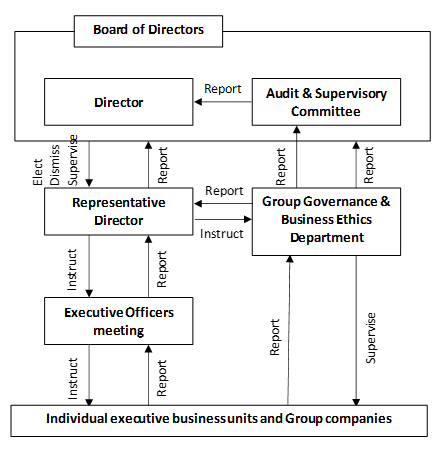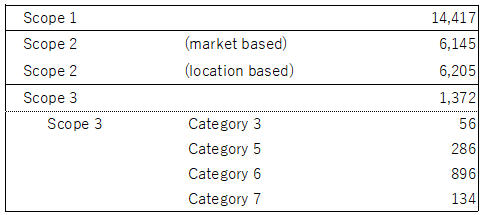■Disclosure based on TCFD recommendations
【Disclosure based on TCFD recommendations】
Wismettac Group (the Company) established a "Basic Policy on Sustainability" and based on this policy, the Company defined key issues (Materiality) and initiatives as a part of sustainable business management. One of the key issues identified was to "Mitigate and adapt to climate change."
To address this climate issue, the Company incorporated TCFD recommendations to analyze and disclose how risks and opportunities related to climate change affect the Company's business.

【Governance】
Important considerations related to climate change are decided by the Board of Directors which is chaired by the Chairman and CEO.
The Group Governance & Business Ethics Department, which reports directly to the Chairman and CEO, discusses and monitors risks and opportunities related to climate change. The details are reported to the Board of Directors and the Audit and Supervisory Committee quarterly for discussion. The decisions made by the Board of Directors are incorporated into the actions of business operations and all entities within the Company.
Through this process, the Company integrates climate change related actions into the group-level management strategy.

【Strategy】
Scenario analysis based on carbon neutrality in 2050 was applied to identify climate-related risks and opportunities.
The Company used 4°C and 1.5°C Scenarios developed by IPCC (Intergovernmental Panel on Climate Change) and the International Energy Agency (IEA) to qualitatively analyze the climate impact. 4°C Scenario assumes that by 2100, the global average temperature would be approximately 4°C higher than during the time of Industrial Revolution and 1.5°C Scenario (partly applying a 2°C Scenario) assumes that by 2100, the global average temperature would be limited to approximately 1.5°C to 2°C higher than during the time of Industrial Revolution.
Under the 4°C Scenario, the physical impacts of storms and floods are expected to be more pervasive and intense. It is also expected that the price of crude oil will rise due to a growing demand for fossil fuels.
The Company contracts with shipping companies for global ocean freight, and operates its own truck fleets for land transportation; hence, the Company has concluded that logistics and fossil fuels have material impact on its business.
To address the risks identified in the 4°C Scenario, the Company took measures to strengthen BCP (Business Continuity Plan) and promote energy conservation measures.The Company streamlined the BCP through establishing a process for initial response in confirming employee safety. Further, BCP includes actions related to consideration of alternative suppliers, selection of substitute warehouses and plans to transfer inventory, and protection and utilization of available assets until business recovery. These BCP activities contribute to prompt resumption of critical operations. Seafood is one of the Company's major categories of product offering. The Company supports sustainable seafood business by expanding the product offering to include seafood with sustainable seafood certification and promoting seafood originating from land-based fish farming.The Company is promoting the use of LEDs in offices and warehouses to conserve energy.
On the other hand, the 1.5°C Scenario assumes that the trend toward carbon neutrality in 2050 will lead to more stringent regulations and require more technological innovations to limit the temperature rise.
For example, a more stringent regulatory carbon pricing system aimed at limiting greenhouse gas emissions could have a financial impact on the overall business operations of the Company.In particular, since the Company operates its own truck fleet system, the Company assesses that the Company's logistics will be highly impacted.The Company's analysis also indicates that increased consumer interest in environmental considerations may lead to changes in consumer preferences and demand.
As for the risks and opportunities identified and assessed in the 1.5°C Scenario, the Company takes initiatives to improve collection of Company's group-level data of CO2 emissions (Scope 1, 2, and 3), increase the efficiency of energy use, and offer environmentally friendly products.While the Company continues to gather its CO2 emissions data (Scope 1, 2, and 3), the Company is also taking initiatives to identify effective emission reduction plan through analyzing energy usage and potential transition to the use of renewable energy.
Food donations made by the Company to food banks support reduction of food loss and CO2 emissions (Scope 3).Some examples of the Company's environmentally friendly product offering include seafood with sustainable seafood certification, plant-based foods, and using packing materials with reduced plastics.
For key risks identified through qualitative analysis, the Company plans to take steps to conduct quantitative analysis. For both two scenarios identified in the analysis, the Company has taken steps to sustainably continue its business and contribute to a sustainable society through its food business.
| Major Risks and opportunity | Factors and Events |
| Transition Risk | Increase in operating costs due to introduction of carbon tax |
| Physical Risk | Disruption of product supply or deterioration of product quality due to damage to company's warehouse operational locations and supply chains due to extreme weather. |
| Opportunity | Increasing demand for environmentally friendly products and seafood with sustainable seafood certification. |
【Risk Management】
The Risk Management Division coordinates to examine and draft risk management-related matters in cooperation with relevant departments. Important matters are submitted or reported to the Board of Directors meeting held on a quarterly basis.
The Group Governance & Business Ethics Department, which reports directly to the Chairman and CEO, conducts management activities to address the risks and opportunities posed by climate change.
<Role of the Group Governance & Business Ethics Department (TCFD-related)>
The Group Governance & Business Ethics Department identifies and evaluates the risks and opportunities caused by climate change throughout the Company. It reports to the Audit and Supervisory Committee and the Board of Directors on a quarterly basis. The Group's Basic Sustainability Policy and materiality are determined by the Board of Directors.The Group Governance & Business Ethics Department monitors the activities of all business operations including those of all entities within the Company, and reports to the Board of Directors and the Audit and Supervisory Committee.
In addition, the Food Safety & Traceability Management Division has been established as the Company believes that risk management related to food safety is paramount to its food business.
The Food Safety & Traceability Management Division monitors, resolves and implements any remedial actions required as a result of safety incidents throughout the Group. The Food Safety & Traceability Management Division reports its activities to the Board of Directors (generally on a quarterly basis). Incidents related to food safety include those caused by the climate change. Through collaboration and information sharing between Food Safety & Traceability Management Division and the Group Governance & Business Ethics Division, the Company effectively manages risks related to climate change.
【Metrics and Targets】
The Company is working to establish a plan for carbon neutrality by 2050 and contribute to the global decarbonization.The Company continues to increase visibility of CO2 emissions (Scope 1, 2, and 3) from Japan and overseas locations while improving the CO2 emissions calculation process to enable continual monitoring.In the future, the Company will implement measures to reduce emissions, including setting reduction targets.
Verified greenhouse gas emissions (t-CO2e)*

※ The Company requested Japan Management Association to provide a limited assurance of our CO2 emissions data and the results are described in the attached "Greenhouse Gas Emissions Verification Report."

